lights TOYOTA BZ4X 2022 (in English) User Guide
[x] Cancel search | Manufacturer: TOYOTA, Model Year: 2022, Model line: BZ4X, Model: TOYOTA BZ4X 2022Pages: 674, PDF Size: 120.02 MB
Page 26 of 674
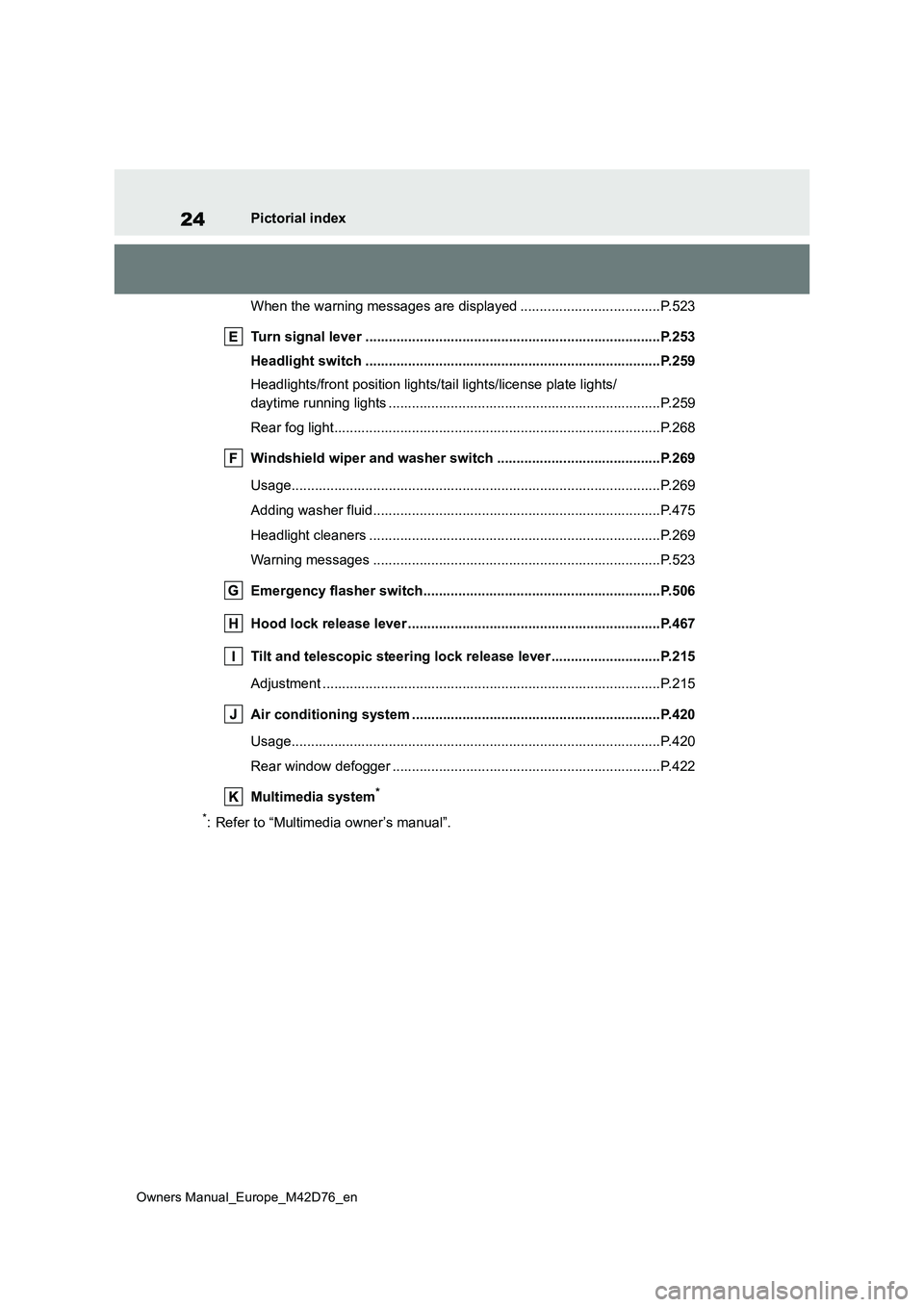
24
Owners Manual_Europe_M42D76_en
Pictorial index
When the warning messages are displayed ........................ ............P.523
Turn signal lever .............................................. ..............................P.253
Headlight switch ............................................... .............................P.259
Headlights/front position lights/tail lights/license plate ligh ts/
daytime running lights ......................................... .............................P.259
Rear fog light................................................. ...................................P.268
Windshield wiper and washer switch ............................. .............P.269
Usage.......................................................... .....................................P.269
Adding washer fluid............................................ ..............................P.475
Headlight cleaners ............................................. ..............................P.269
Warning messages ............................................... ...........................P.523
Emergency flasher switch....................................... ......................P.506
Hood lock release lever ........................................ .........................P.467
Tilt and telescopic steering lock release lever................ ............P.215
Adjustment ..................................................... ..................................P.215
Air conditioning system ........................................ ........................P.420
Usage.......................................................... .....................................P.420
Rear window defogger ........................................... ..........................P.422
Multimedia system*
*: Refer to “Multimedia owner’s manual”.
Page 31 of 674
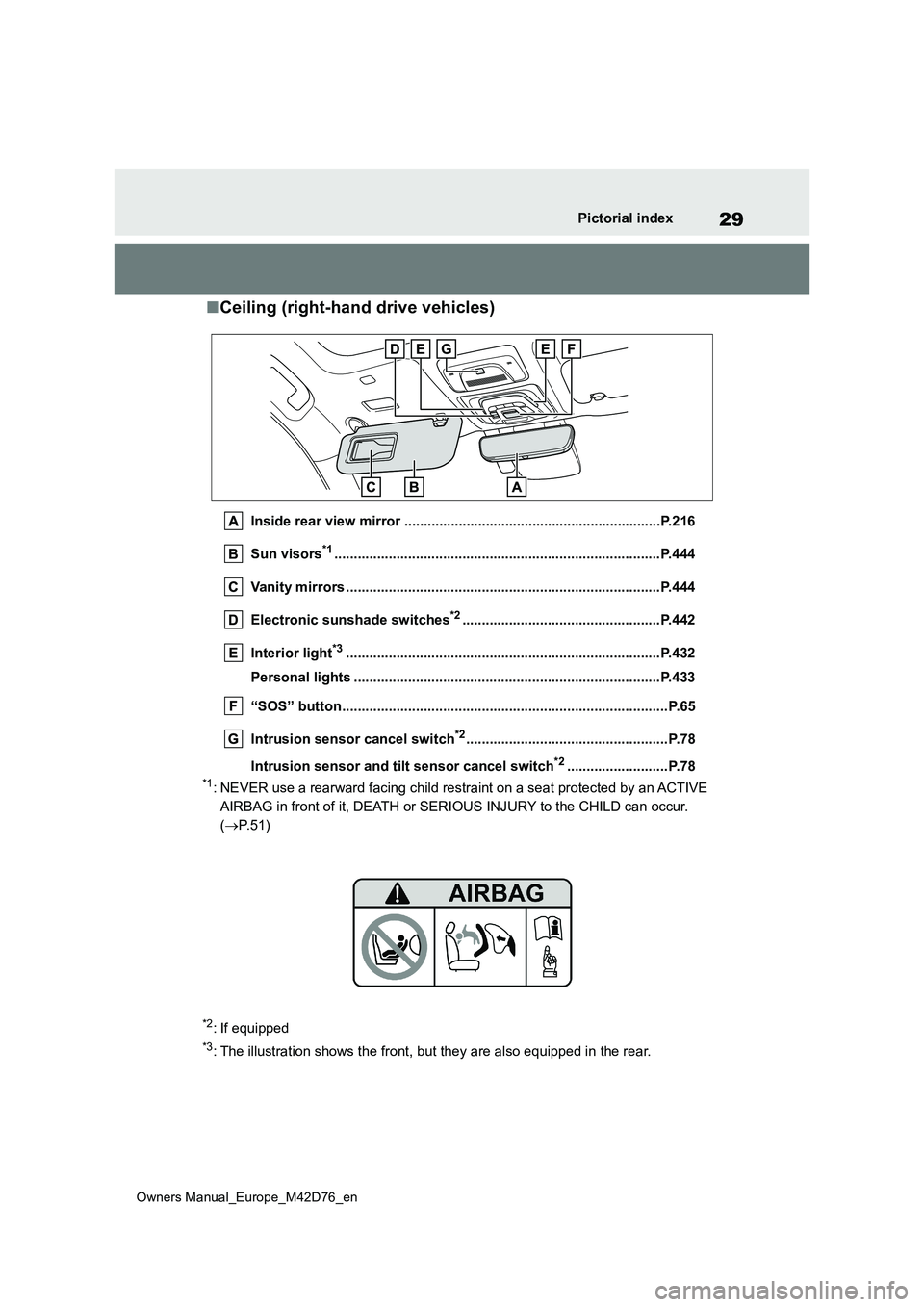
29
Owners Manual_Europe_M42D76_en
Pictorial index
■Ceiling (right-hand drive vehicles)
Inside rear view mirror ..................................................................P.216
Sun visors*1............................................................... .....................P.444
Vanity mirrors ................................................. ................................P.444
Electronic sunshade switches*2...................................................P.442
Interior light*3............................................................... ..................P.432
Personal lights ................................................ ...............................P.433
“SOS” button................................................... .................................P.65
Intrusion sensor cancel switch*2....................................................P.78
Intrusion sensor and tilt sensor cancel switch*2..........................P.78
*1: NEVER use a rearward facing child restraint on a seat protecte d by an ACTIVE
AIRBAG in front of it, DEATH or SERIOUS INJURY to the CHILD can occur.
( P.51)
*2: If equipped
*3: The illustration shows the front, but they are also equipped in the rear.
Page 42 of 674
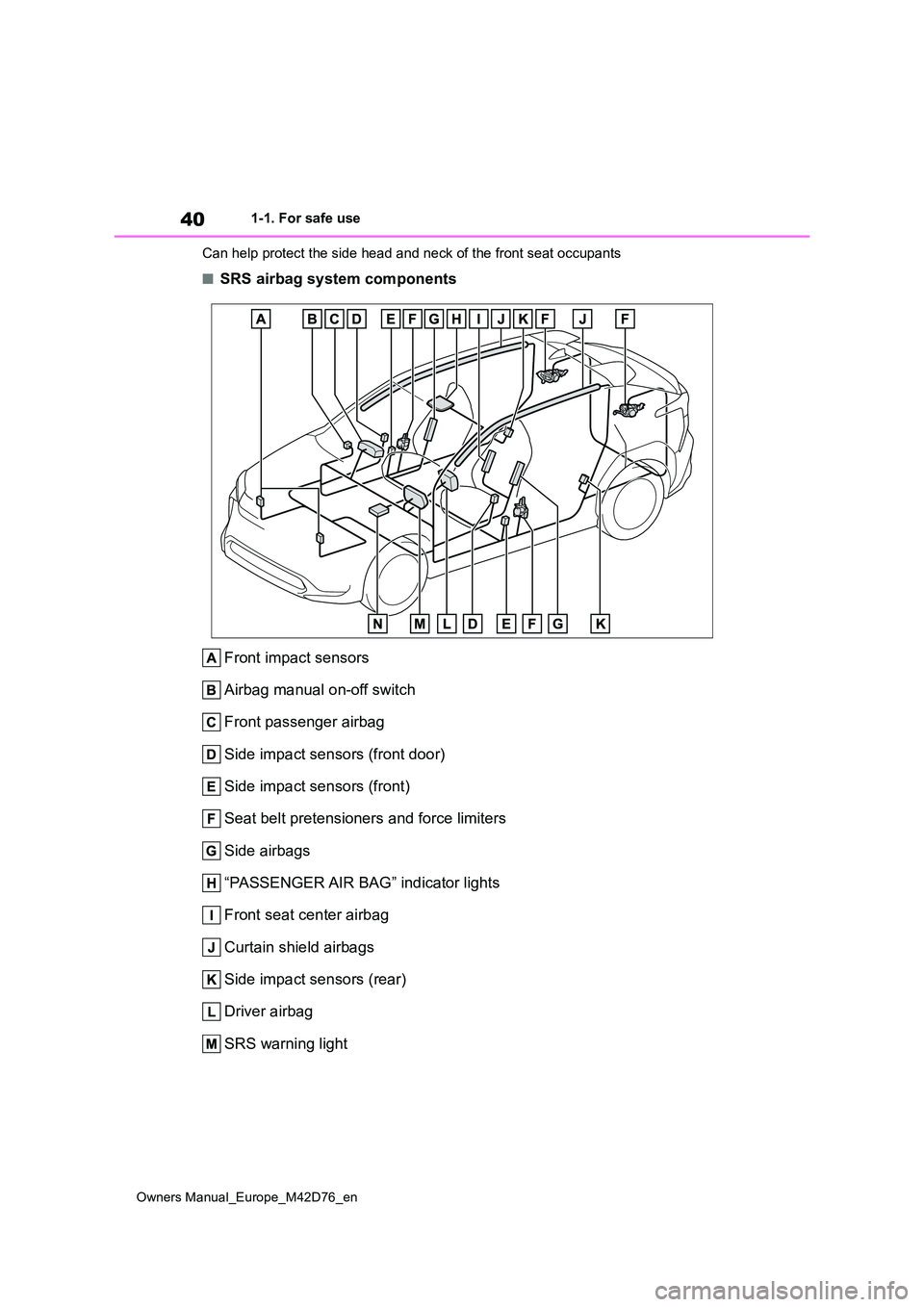
40
Owners Manual_Europe_M42D76_en
1-1. For safe use
Can help protect the side head and neck of the front seat occup ants
■SRS airbag system components
Front impact sensors
Airbag manual on-off switch
Front passenger airbag
Side impact sensors (front door)
Side impact sensors (front)
Seat belt pretensioners and force limiters
Side airbags
“PASSENGER AIR BAG” indicator lights
Front seat center airbag
Curtain shield airbags
Side impact sensors (rear)
Driver airbag
SRS warning light
Page 43 of 674
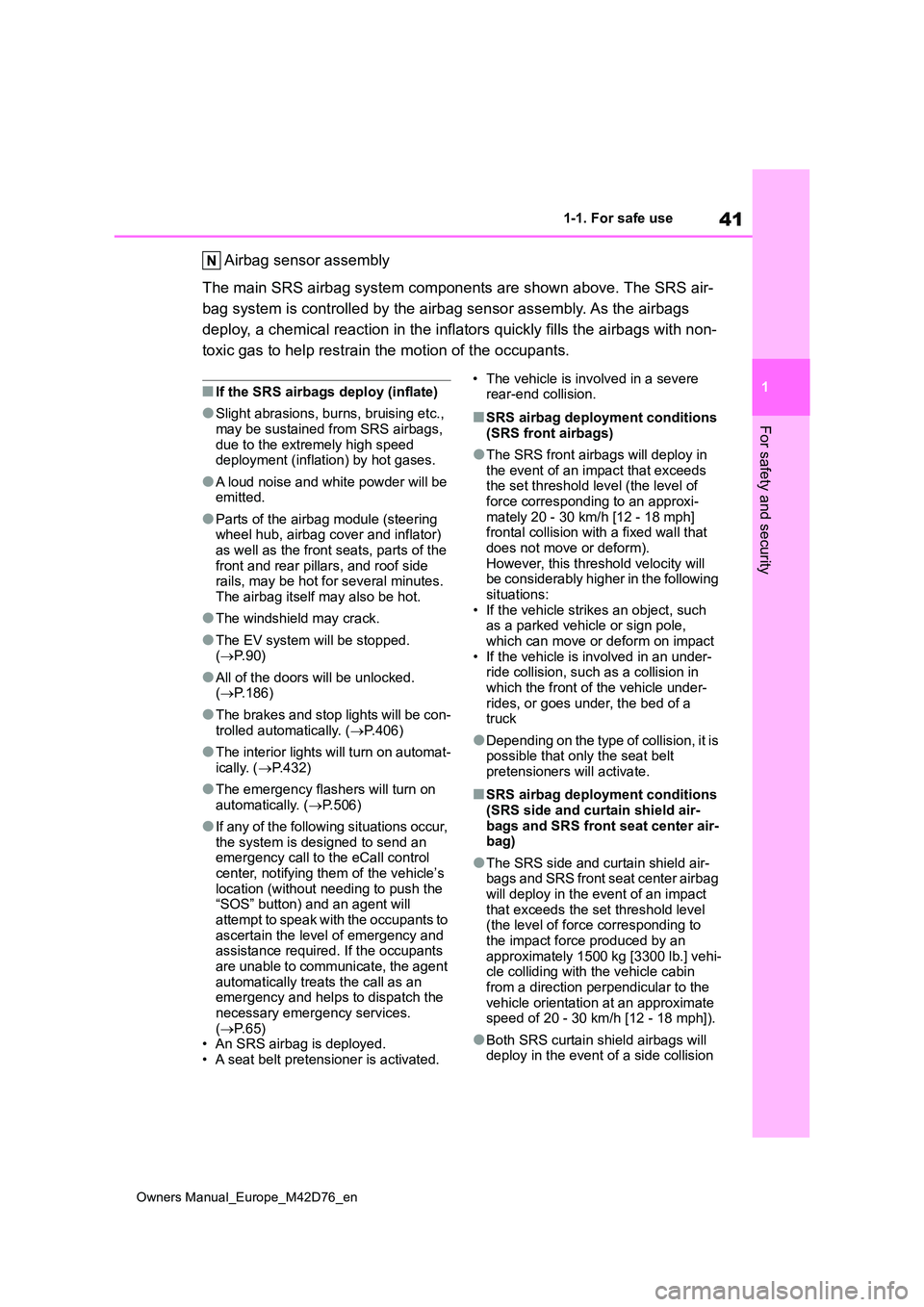
41
1
Owners Manual_Europe_M42D76_en
1-1. For safe use
For safety and security
Airbag sensor assembly
The main SRS airbag system components are shown above. The SRS air-
bag system is controlled by the airbag sensor assembly. As the airbags
deploy, a chemical reaction in the inflators quickly fills the airbags with non-
toxic gas to help restrain the motion of the occupants.
■If the SRS airbags deploy (inflate)
●Slight abrasions, burns, bruising etc.,
may be sustained from SRS airbags, due to the extremely high speed deployment (inflation) by hot gases.
●A loud noise and white powder will be emitted.
●Parts of the airbag module (steering wheel hub, airbag cover and inflator)
as well as the front seats, parts of the front and rear pillars, and roof side rails, may be hot for several minutes.
The airbag itself may also be hot.
●The windshield may crack.
●The EV system will be stopped. ( P. 9 0 )
●All of the doors will be unlocked. ( P.186)
●The brakes and stop lights will be con-
trolled automatically. ( P.406)
●The interior lights will turn on automat-
ically. ( P.432)
●The emergency flashers will turn on
automatically. ( P.506)
●If any of the following situations occur,
the system is designed to send an emergency call to the eCall control center, notifying them of the vehicle’s
location (without needing to push the “SOS” button) and an agent will attempt to speak with the occupants to
ascertain the level of emergency and assistance required. If the occupants are unable to communicate, the agent
automatically treats the call as an emergency and helps to dispatch the necessary emergency services.
( P. 6 5 ) • An SRS airbag is deployed.• A seat belt pretensioner is activated.
• The vehicle is involved in a severe rear-end collision.
■SRS airbag deployment conditions
(SRS front airbags)
●The SRS front airbags will deploy in
the event of an impact that exceeds the set threshold level (the level of force corresponding to an approxi-
mately 20 - 30 km/h [12 - 18 mph] frontal collision with a fixed wall that does not move or deform).
However, this threshold velocity will be considerably higher in the following situations:
• If the vehicle strikes an object, such as a parked vehicle or sign pole, which can move or deform on impact
• If the vehicle is involved in an under- ride collision, such as a collision in which the front of the vehicle under-
rides, or goes under, the bed of a truck
●Depending on the type of collision, it is possible that only the seat belt pretensioners will activate.
■SRS airbag deployment conditions
(SRS side and curtain shield air- bags and SRS front seat center air-bag)
●The SRS side and curtain shield air-bags and SRS front seat center airbag
will deploy in the event of an impact that exceeds the set threshold level (the level of force corresponding to
the impact force produced by an approximately 1500 kg [3300 lb.] vehi-cle colliding with the vehicle cabin
from a direction perpendicular to the vehicle orientation at an approximate speed of 20 - 30 km/h [12 - 18 mph]).
●Both SRS curtain shield airbags will deploy in the event of a side collision
Page 67 of 674

65
1
Owners Manual_Europe_M42D76_en
1-3. Emergency assistance
For safety and security
1-3.Emerg ency as sista nce
*: Operates within the eCall coverage.
The system name differs depending
on the country.
Microphone
“SOS” button*
Indicator lights
Speaker
*: This button is intended for communi-
cation with the eCall system operator.
Other SOS buttons available in other
systems of a motor vehicle do not
relate to the device and are not
intended for communication with the
eCall system operator.
■Automatic Emergency Calls
If any airbag deploys, the system is
designed to automatically call the
eCall control center.* The answer-
ing operator receives the vehicle’s
location, the time of the incident
and the vehicle VIN, and attempts
to speak with the vehicle occupants
to assess the situation. If the occu-
pants are unable to communicate,
the operator automatically treats
the call as an emergency and con-
tacts the nearest emergency ser-
vices provider (112 system etc.) to
describe the situation and request
that assistance be sent to the loca-
tion.
*: In some cases, the call cannot be
made. ( P. 6 6 )
■Manual Emergency Calls
In the event of an emergency, press
the “SOS” button to call the eCall
control center.* The answering
operator will determine your vehi-
cle’s location, assess the situation,
and dispatch the necessary assis-
eCall*
eCall is a telematics service
that uses Global Navigation
Satellite System (GNSS) data
and embedded cellular tech-
nology to enable the following
emergency calls to be made:
Automatic emergency calls
(Automatic Collision Notifica-
tion) and manual emergency
calls (by pressing the “SOS”
button). This service is
required by European Union
Regulations.
System components
Emergency Notification Ser-
vices
Page 68 of 674

66
Owners Manual_Europe_M42D76_en
1-3. Emergency assistance
tance required.
Make sure to open the cover before
pressing the “SOS” button.
If you accidentally press the “SOS” but-
ton, tell the operator that you are not
experiencing an emergency.
*: In some cases, the call cannot be
made. ( P. 6 6 )
When the power switch is turned to
ON, the red indicator light will illumi-
nate for 10 seconds and then the
green indicator light will illuminate,
indicating that the system is
enabled. The indicator lights indi-
cate the following:
If the green indicator light illumi-
nates and stays on, the system is
enabled.
If the green indicator light
flashes, an automatic or manual
Emergency Call is being made.
If the red indicator light illumi-
nates and a buzzer sounds 5
times (on some models) at any
time other than immediately after
the power switch is turned to ON,
the system may be malfunction-
ing or the backup battery may be
depleted.
If the red indicator light blinks for
approximately 30 seconds during
an Emergency Call, the call has
been disconnected or the cellular
network signal is weak.
Indicator lights
WARNING
■When the Emergency Call may not be made
●It may not be possible to make Emergency Calls in any of the fol-lowing situations. In such cases,
report to emergency services pro- vider (112 system etc.) by other means such as nearby public
phones.
• Even when the vehicle is in the cel- lular phone service area, it may be
difficult to connect to the eCall con- trol center if the reception is poor or the line is busy. In such cases, even
though the system attempts to con- nect to the eCall control center, you may not be able to connect to the
eCall control center to make Emer- gency Calls and contact emergency services.
• When the vehicle is out of the cellu- lar phone service area, the Emer-
gency Calls cannot be made.
• When any related equipment (such
as the “SOS” button panel, indicator lights, microphone, speaker, DCM, antenna, or any wires connecting
the equipment) is malfunctioning, damaged or broken, the Emer-gency Call cannot be made.
Page 85 of 674
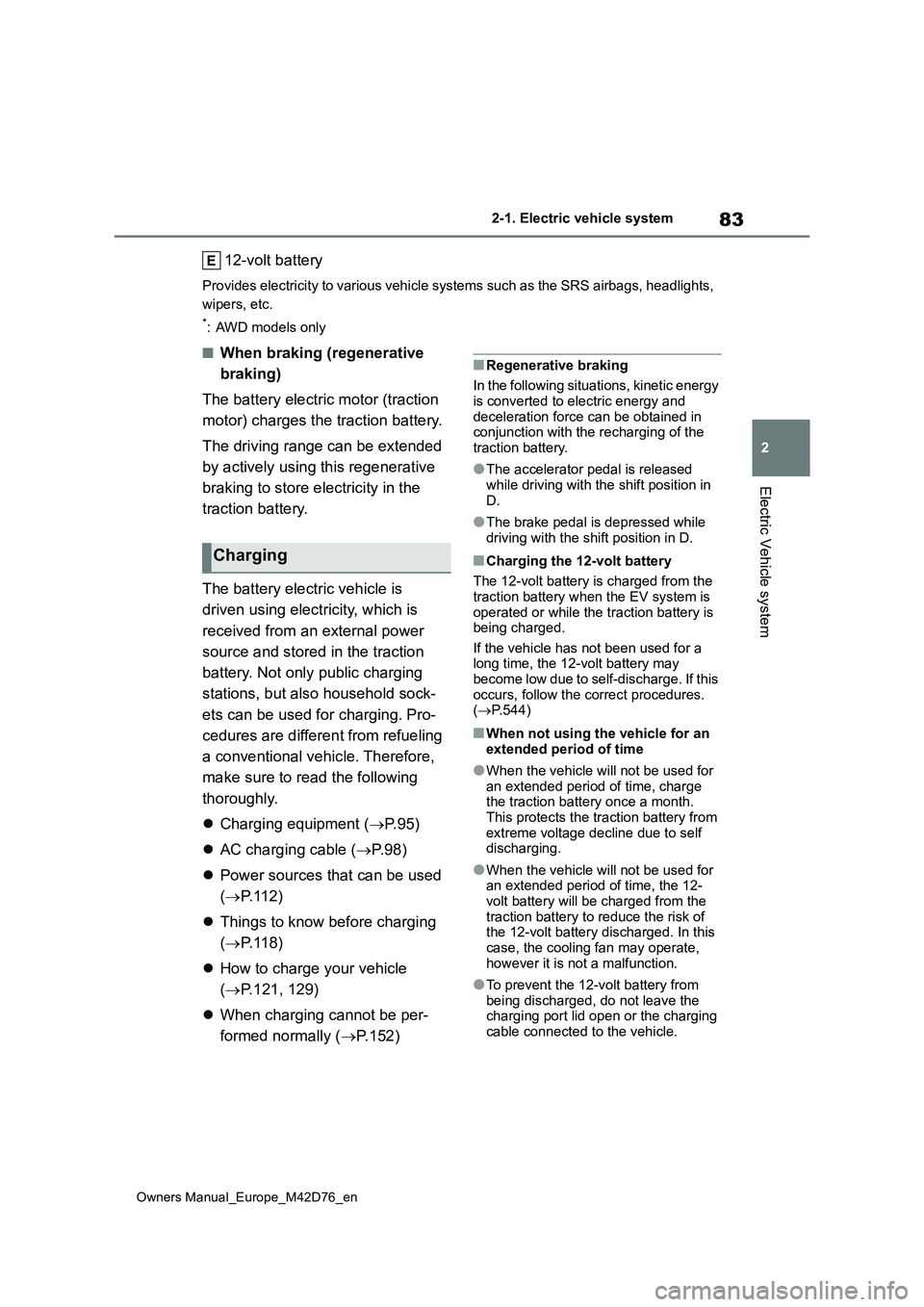
83
2
Owners Manual_Europe_M42D76_en
2-1. Electric vehicle system
Electric Vehicle system
12-volt battery
Provides electricity to various vehicle systems such as the SRS airbags, headlights,
wipers, etc.
*: AWD models only
■When braking (regenerative
braking)
The battery electric motor (traction
motor) charges the traction battery.
The driving range can be extended
by actively using this regenerative
braking to store electricity in the
traction battery.
The battery electric vehicle is
driven using electricity, which is
received from an external power
source and stored in the traction
battery. Not only public charging
stations, but also household sock-
ets can be used for charging. Pro-
cedures are different from refueling
a conventional vehicle. Therefore,
make sure to read the following
thoroughly.
Charging equipment (P.95)
AC charging cable (P. 9 8 )
Power sources that can be used
( P.112)
Things to know before charging
( P.118)
How to charge your vehicle
( P.121, 129)
When charging cannot be per-
formed normally ( P.152)
■Regenerative braking
In the following situations, kinetic energy
is converted to electric energy and deceleration force can be obtained in conjunction with the recharging of the
traction battery.
●The accelerator pedal is released
while driving with the shift position in D.
●The brake pedal is depressed while driving with the shift position in D.
■Charging the 12-volt battery
The 12-volt battery is charged from the
traction battery when the EV system is operated or while the traction battery is being charged.
If the vehicle has not been used for a long time, the 12-volt battery may become low due to self-discharge. If this
occurs, follow the correct procedures. ( P.544)
■When not using the vehicle for an
extended period of time
●When the vehicle will not be used for
an extended period of time, charge the traction battery once a month. This protects the traction battery from
extreme voltage decline due to self discharging.
●When the vehicle will not be used for an extended period of time, the 12-volt battery will be charged from the
traction battery to reduce the risk of the 12-volt battery discharged. In this case, the cooling fan may operate,
however it is not a malfunction.
●To prevent the 12-volt battery from
being discharged, do not leave the charging port lid open or the charging cable connected to the vehicle.
Charging
Page 93 of 674

91
2
Owners Manual_Europe_M42D76_en
2-1. Electric vehicle system
Electric Vehicle system
Shift the shift position to D when
stopped at a traffic light, or driving
in heavy traffic, etc. Shift the shift
position to P when parking. When
shifting the shift position to N while
driving, there is no positive effect
on electricity consumption. In the N,
the traction battery cannot be
charged. Also, when using the air
conditioning system, etc., the trac-
tion battery electricity is consumed.
( P.248)
Repeated acceleration and decel-
eration due to traffic congestion,
long waits at traffic lights, and driv-
ing on steep inclines will lead to
poor electricity consumption. In
order to avoid those situations as
much as possible, check traffic
reports before leaving. If the vehicle
is driven in traffic congestion, gently
release the brake pedal to allow the
vehicle to move forward slightly,
avoid overuse of the accelerator
pedal. Doing so can help minimize
unnecessary electricity consump-
tion.
Make sure to operate the brakes
gently and a timely manner. A
greater amount of electrical energy
can be regenerated when slowing
down.
Control and maintain the vehicle at
a constant speed. Before stopping
at a toll booth or similar, allow
plenty of time to release the accel-
erator and gently apply the brakes.
A greater amount of electrical
energy can be regenerated when
slowing down.
Batter y Electric Vehicle
driving tips
Unlike the conventional vehi-
cles, the electricity consump-
tion efficiency of battery
electric vehicles will decline if
they continue driving on high-
ways (or freeways) or at high
average speeds, causing the
possible driving distance to
reduce. Therefore, if the
remaining charge of the trac-
tion battery is low, avoid rely-
ing on the displayed possible
driving distance too much as
well as driving on highways (or
freeways). Driving the vehicle
at moderate speeds, the trac-
tion battery’s electricity con-
sumption can be controlled.
The following driving tips will
contribute to reduction in the
battery consumption and
increase in the driving range.
Shift position operation
Delays
When braking
Highway (or freeways) driv-
ing
Page 121 of 674
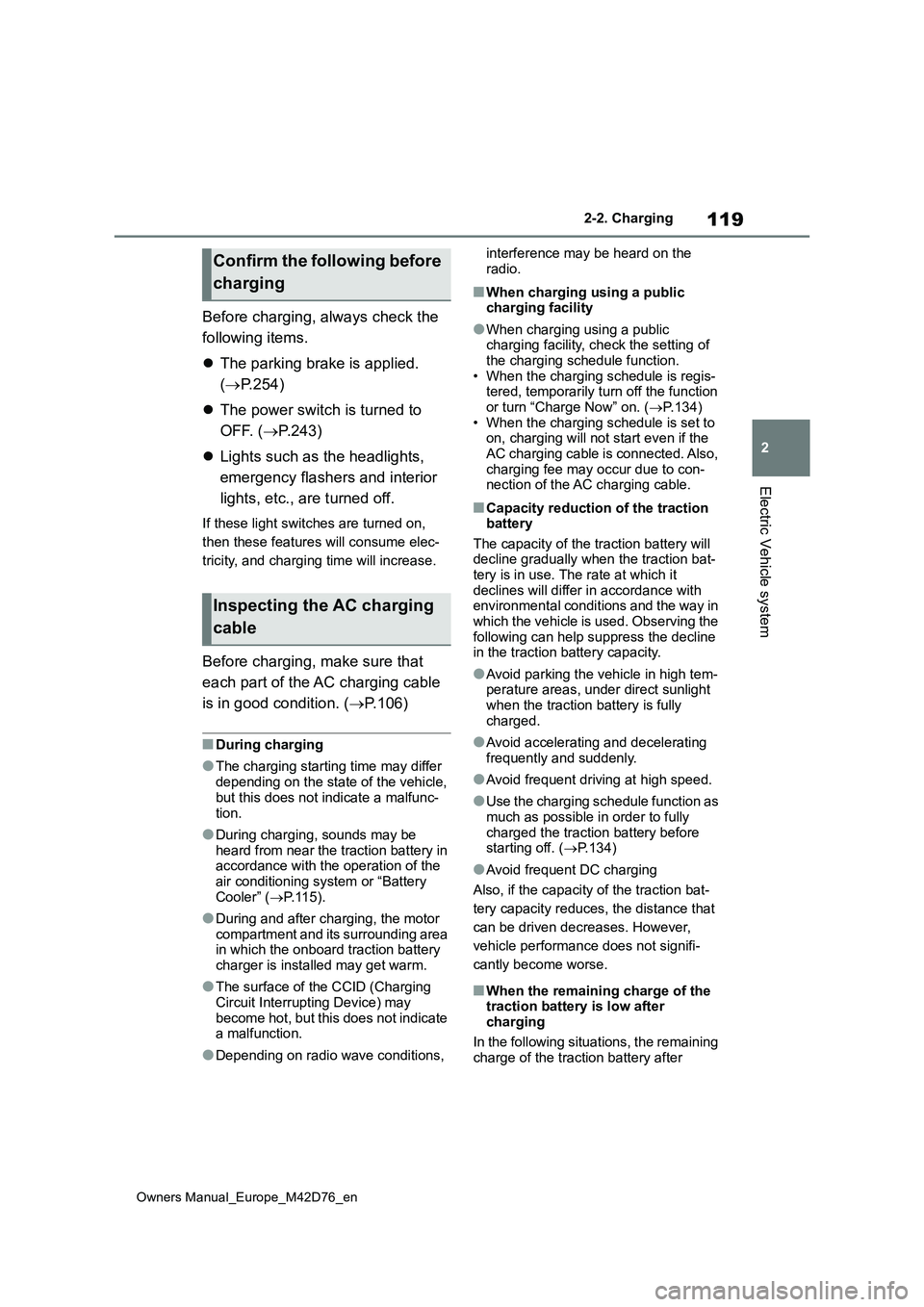
119
2
Owners Manual_Europe_M42D76_en
2-2. Charging
Electric Vehicle system
Before charging, always check the
following items.
The parking brake is applied.
( P.254)
The power switch is turned to
OFF. ( P.243)
Lights such as the headlights,
emergency flashers and interior
lights, etc., are turned off.
If these light switches are turned on,
then these features will consume elec-
tricity, and charging time will increase.
Before charging, make sure that
each part of the AC charging cable
is in good condition. ( P.106)
■During charging
●The charging starting time may differ
depending on the state of the vehicle, but this does not indicate a malfunc-
tion.
●During charging, sounds may be
heard from near the traction battery in accordance with the operation of the air conditioning system or “Battery
Cooler” ( P.115).
●During and after charging, the motor
compartment and its surrounding area in which the onboard traction battery charger is installed may get warm.
●The surface of the CCID (Charging Circuit Interrupting Device) may
become hot, but this does not indicate a malfunction.
●Depending on radio wave conditions,
interference may be heard on the
radio.
■When charging using a public charging facility
●When charging using a public charging facility, check the setting of the charging schedule function.
• When the charging schedule is regis- tered, temporarily turn off the function or turn “Charge Now” on. ( P.134)
• When the charging schedule is set to on, charging will not start even if the AC charging cable is connected. Also,
charging fee may occur due to con- nection of the AC charging cable.
■Capacity reduction of the traction battery
The capacity of the traction battery will decline gradually when the traction bat-tery is in use. The rate at which it
declines will differ in accordance with environmental conditions and the way in which the vehicle is used. Observing the
following can help suppress the decline in the traction battery capacity.
●Avoid parking the vehicle in high tem-perature areas, under direct sunlight when the traction battery is fully
charged.
●Avoid accelerating and decelerating
frequently and suddenly.
●Avoid frequent driving at high speed.
●Use the charging schedule function as much as possible in order to fully
charged the traction battery before starting off. ( P.134)
●Avoid frequent DC charging
Also, if the capacity of the traction bat-
tery capacity reduces, the distance that
can be driven decreases. However,
vehicle performance does not signifi-
cantly become worse.
■When the remaining charge of the traction battery is low after charging
In the following situations, the remaining charge of the traction battery after
Confirm the following before
charging
Inspecting the AC charging
cable
Page 122 of 674
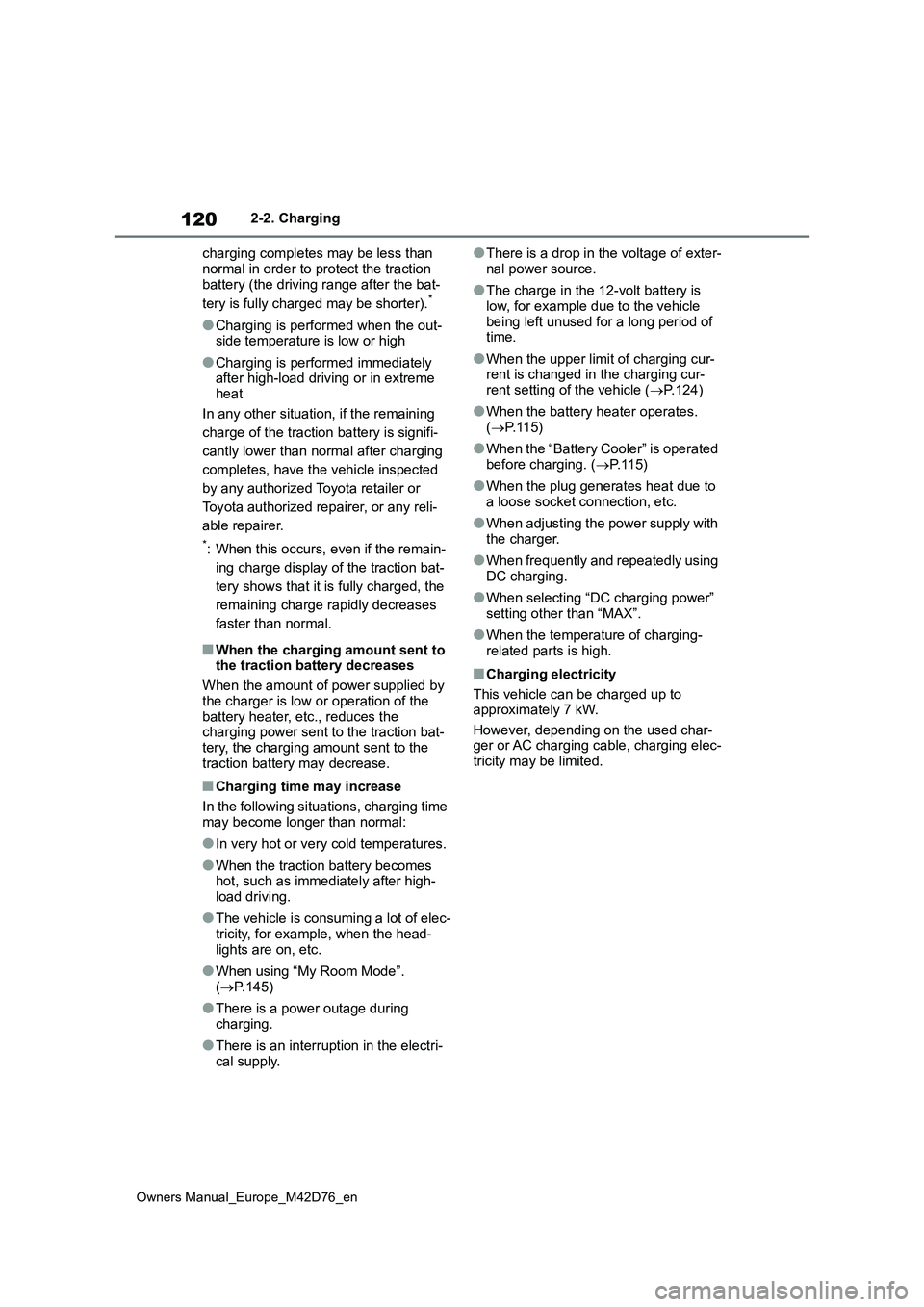
120
Owners Manual_Europe_M42D76_en
2-2. Charging
charging completes may be less than
normal in order to protect the traction battery (the driving range after the bat-
tery is fully charged may be shorter).*
●Charging is performed when the out- side temperature is low or high
●Charging is performed immediately after high-load driving or in extreme
heat
In any other situation, if the remaining
charge of the traction battery is signifi-
cantly lower than normal after charging
completes, have the vehicle inspected
by any authorized Toyota retailer or
Toyota authorized repairer, or any reli-
able repairer.
*: When this occurs, even if the remain-
ing charge display of the traction bat-
tery shows that it is fully charged, the
remaining charge rapidly decreases
faster than normal.
■When the charging amount sent to the traction battery decreases
When the amount of power supplied by
the charger is low or operation of the battery heater, etc., reduces the charging power sent to the traction bat-
tery, the charging amount sent to the traction battery may decrease.
■Charging time may increase
In the following situations, charging time
may become longer than normal:
●In very hot or very cold temperatures.
●When the traction battery becomes hot, such as immediately after high-
load driving.
●The vehicle is consuming a lot of elec-
tricity, for example, when the head- lights are on, etc.
●When using “My Room Mode”. ( P.145)
●There is a power outage during charging.
●There is an interruption in the electri-cal supply.
●There is a drop in the voltage of exter-
nal power source.
●The charge in the 12-volt battery is
low, for example due to the vehicle being left unused for a long period of time.
●When the upper limit of charging cur-rent is changed in the charging cur-
rent setting of the vehicle ( P.124)
●When the battery heater operates.
( P. 1 1 5 )
●When the “Battery Cooler” is operated
before charging. ( P. 1 1 5 )
●When the plug generates heat due to
a loose socket connection, etc.
●When adjusting the power supply with
the charger.
●When frequently and repeatedly using
DC charging.
●When selecting “DC charging power”
setting other than “MAX”.
●When the temperature of charging-
related parts is high.
■Charging electricity
This vehicle can be charged up to approximately 7 kW.
However, depending on the used char- ger or AC charging cable, charging elec-tricity may be limited.